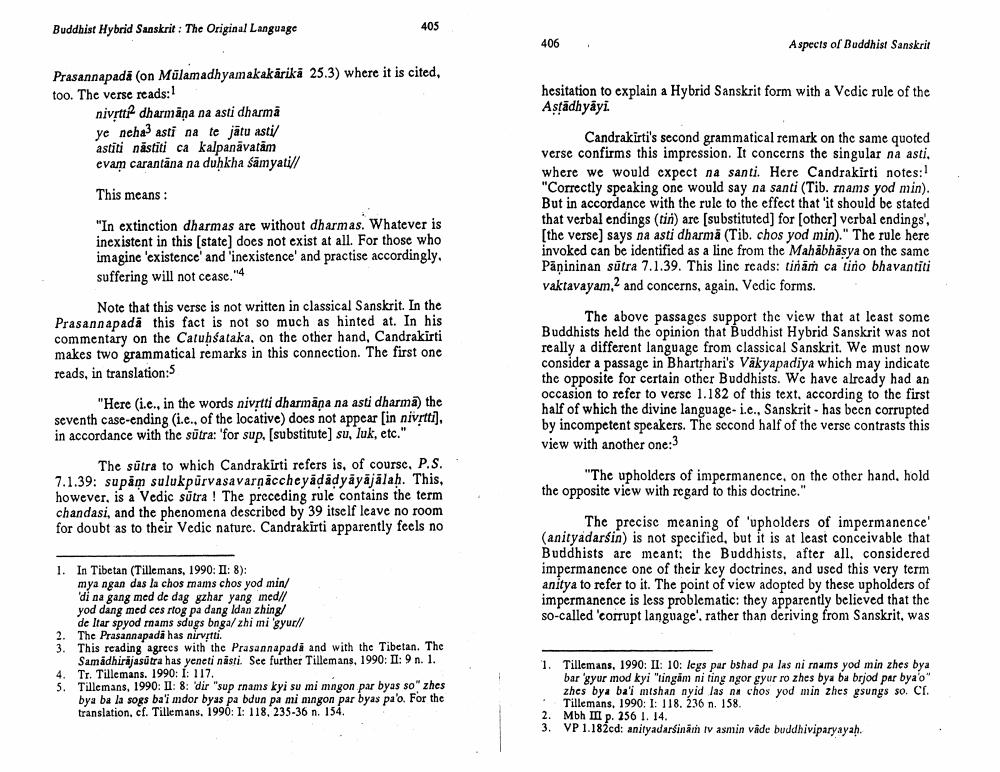Book Title: Buddhist Hybrid Sanskrit Original Language Author(s): Johannes Bronkhorst Publisher: Johannes Bronkhorst View full book textPage 6
________________ Buddhist Hybrid Sanskrit : The Original Language 405 406 Aspects of Buddhist Sanskrit hesitation to explain a Hybrid Sanskrit form with a Vedic rule of the Astādhyāyi. Prasannapada (on Mülamadhyamakakärikä 25.3) where it is cited, too. The verse reads: nivrttidharmaņa na asti dharma ye neha? asti na te jātu asti astiti năstiti ca kalpanāvatam evam carantāna na duhkha śāmyati/ This means : Candrakirti's second grammatical remark on the same quoted verse confirms this impression. It concerns the singular na asti, where we would cxpect na santi. Here Candrakirti notes: "Correctly speaking one would say na santi (Tib. rnams yod min). But in accordance with the rule to the effect that it should be stated that verbal endings (tin) arc (substituted) for (other) verbal endings', (the verse) says na asti dharma (Tib. chos yod min)." The rule here invoked can be identified as a line from the Mahabhäsya on the same Panininan sutra 7.1.39. This linc reads: tināṁ ca tiro bhavantiti vaktavayam 2 and concerns, again. Vedic forms. "In extinction dharmas are without dharmas. Whatever is inexistent in this (state) does not exist at all. For those who imagine 'existence' and 'inexistence and practise accordingly, suffering will not ceasc.4 Note that this verse is not written in classical Sanskrit. In the Prasannapadá this fact is not so much as hinted at. In his commentary on the Catuhsataka, on the other hand, Candrakirti makes two grammatical remarks in this connection. The first one reads, in translation: The above passages support the view that at least some Buddhists held the opinion that Buddhist Hybrid Sanskrit was not really a different language from classical Sanskrit. We must now consider a passage in Bhartrhari's Väkyapadiya which may indicate the opposite for certain other Buddhists. We have alrcady had an occasion to refer to verse 1.182 of this text, according to the first half of which the divine language- i.e., Sanskrit - has been corrupted by incompetent speakers. The second half of the verse contrasts this view with another one:3 "Here (i.c., in the words nivrtti dharmana na asti dharma) the seventh case-ending (i.c., of the locative) does not appear in nivetti). in accordance with the sūtra: 'for sup. (substitute] su, luk, etc." The sutra to which Candrakirti refers is, of course, P.S. 7.1.39: supam sulukpurvasavarnaccheydädyäyäjälah. This, however, is a Vedic sutra ! The preceding rule contains the term chandasi, and the phenomena described by 39 itself leave no room for doubt as to their Vedic nature. Candrakirti apparently feels no "The upholders of impermanence, on the other hand, hold the opposite view with regard to this doctrine." The precise meaning of 'upholders of impermanence' (anityadarsin) is not specified, but it is at least conceivable that Buddhists are meant: the Buddhists, after all, considered impermanence one of their key doctrines, and used this very term anitya to refer to it. The point of view adopted by these upholders of impermanence is less problematic: they apparently believed that the so-called 'corrupt language' rather than deriving from Sanskrit, was 1. In Tibetan (Tillemans, 1990: II: 8): mya ngan das la chos mams chos yod min/ 'di na gang med de dag gzhar yang ined// yod dang med ces rlog pa dang ldan zhing/ de Itar spyod mams sdugs bnga/zhi mi 'gyur// 2. The Prasannapada has nirvitti. 3. This reading agrecs with the Prasannapadi and with the Tibetan. The Samadhirajasūtra has yeneti násti. See further Tillemans, 1990: II: 9 n. 1. 4. Tr. Tillemans. 1990: I: 117. 5. Tillemans, 1990: II: 8: dir "sup rnams kyi su mi mngon par byas so zhes bya ba la sogs ba'i mdor byas pa bdun pa mi mngon par byas pa'o. For the translation, cf. Tillemans. 1990: 1: 118, 235-36 n. 154. 1. Tillemans, 1990: II: 10: legs par bshad pa las ni rnams yod min zhes bya bar 'gyur mod kyi "tingam ni ting ngor gyur ro zhes bya ba brjod par byao" zhes bya ba'i mishan ayid las na chos yod min zhes gsungs so. CI. Tillemans, 1990: 1: 118. 236 n. 158. 2. Mbh II p. 256 I. 14. 3. VP 1.182cd: anityadarsinar Iv asmin vāde buddhiviparyayah.Page Navigation
1 ... 4 5 6 7 8 9 10 11 12 13 14 15
